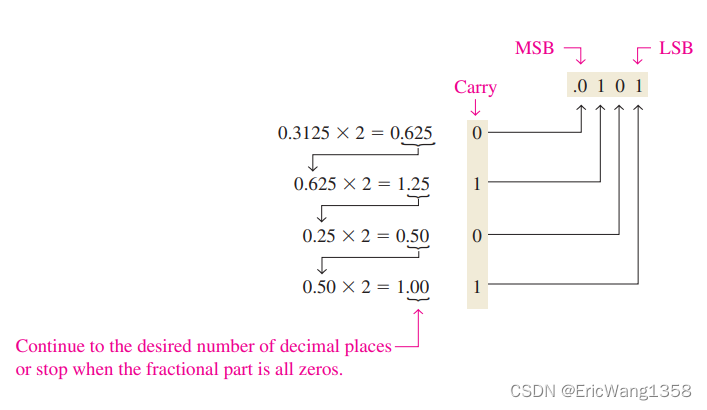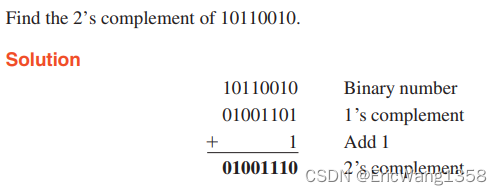[ECE] 2.1 - 2.6 Number Systems, Operations
Decimal versus Binary Numbers
????????Decimal Numbers:?
Each digit takes a value btw 0~9, (decimal point)
????????????????Express the decimal number 47 as a sum of the values of each digit.
????????Binary Numbers:?
Each digit takes a value either 0 or 1, (Binary point)
? ? ? ? ? ? ? ? 0.1011 = 0.5 + 0.125 + 0.0625 = 0.6875
? ? ? ? ? ? ? ? MSB:Most? Significant Bit?
????????????????????????The left-most bit is the MSB (most significant bit); its weight depends on the size of the binary number.
????????????????LSB :Least Significant Bit?
????????????????????????The right-most bit is the LSB (least significant bit) in a binary whole number and has a weight of 20 = 1.
????????????????1. What is the largest decimal number that can be represented in binary with eight bits?
? ? ? ? ? ? ? ? ?A:?255 = 2^8 - 1
Repeated Division-by-2 Method
A systematic method of converting whole numbers from decimal to binary is the repeated division-by-2 process.?For example, to convert the decimal number 12 to binary, begin by dividing 12 by 2. Then divide each resulting quotient by 2 until there is a 0 whole-number quotient. The remainders generated by each division form the binary number.
? ? ? ? ? ? ? ??
?Converting Decimal Fractions to Binary
1.?Sum-of-Weights:?
0.625 = 0.5 + 0.125 = 2^-1 + 2^-3 = 0.101
2.?Repeated Multiplication by 2
For example, to convert the decimal fraction 0.3125 to binary, begin by multiplying 0.3125 by 2 and then multiplying each resulting fractional part of the product by 2 until the fractional product is zero or until the desired number of decimal places is reached. The carry digits, or carries, generated by the multiplications produce the binary number. The first carry produced is the MSB, and the last carry is the LSB. This procedure is illustrated as follows

?( 0.625 's carry is 0, 1.25's carry is 1 )( carry here means "进位” )
Binary Arithmetic
To understand digital systems, you must know the basics of binary addition, substraction, multiplication, and division. This section provides an introduction that will be expanded in later sections.
Binary Addition
0 + 0 = 0 Sum of 0 with a carry of 0
0 + 1 = 1 Sum of 1 with a carry of 0
1 + 0 = 1 Sum of 1 with a carry of 0
1 + 1 = 10 Sum of 0 with a carry of 1
When binary numbers are added, the last condition creates a sum of 0 in a given column and a carry of 1 over to the next column to the left.?When there is a carry of 1, you have a situation in which three bits are being added (a bit in each of the two numbers and a carry bit).
Binary Subtraction
0 - 0 = 0
1 - 1 = 0
1 - 0 = 1
10 - 1 = 1 (0 - 1 with a borrow of 1)

Binary Multiplication
0 * 0 = 0
0 * 1 = 0
1 * 0 = 0
1 * 1 = 1

Binary Division
Division in binary follows the same procedure as division in decimal

Complements of Binary Numbers
The 1’s complement and the 2’s complement of a binary number are important because they permit the representation of negative numbers. The method of 2’s complement arithmetic is commonly used in computers to handle negative numbers.
Finding the 1’s Complement
The 1’s complement of a binary number is found by changing all 1s to 0s and all 0s to 1s.
The simplest way to obtain the 1’s complement of a binary number with a digital circuit is to use parallel inverters (NOT circuits).?

Finding the 2’s Complement
First Method
The 2’s complement of a binary number is found by adding 1 to the LSB of the 1’s complement.
?2's complement = (1's complement) + 1

?An alternative method
Another method of finding the 2’s complement of a binary number is as follows:
1. Start at the right with the LSB and write the bits as they are up to and including the first 1.
2. Take the 1’s complements of the remaining bits

?The 2’s complement of a negative binary number can be realized using inverters and an adder

Signed Numbers
Digital systems, such as the computer, must be able to handle both positive and negative numbers. A signed binary number consists of both sign and magnitude information.
There are three forms in which signed integer (whole) numbers can be represented in binary: sign-magnitude, 1’s complement, and 2’s complement. Of these, the 2’s complement is the most important and the sign-magnitude is the least used. Noninteger and very large or small numbers can be expressed in floating-point format.
The Sign Bit
The left-most bit in a signed binary number is the sign bit, which tells you whether the number is positive or negative.
A 0 sign bit indicates a positive number, and a 1 sign bit indicates a negative number
Sign-Magnitude Form
The left-most bit is the sign bit and the remaining bits are the magnitude bits.
Notice that the only difference between +25 and 225 is the sign bit because the magnitude bits are in true binary for both positive and negative numbers.
(In the sign-magnitude form, a negative number has the same magnitude bits as the corresponding positive number but the sign bit is a 1 rather than a zero.)
1’s Complement Form
In the 1’s complement form, a negative number is the 1’s complement of the corresponding positive number
2’s Complement Form
In the 2’s complement form, a negative number is the 2’s complement of the corresponding positive number
Negative numbers are the 2’s complements of the corresponding positive numbers.
Infonote
Processors use the 2’s complement for negative integer numbers in arithmetic operations. The reason is that subtraction of a number is the same as adding the 2’s complement of the number. Processors form the 2’s complement by inverting the bits and adding 1, using special instructions that produce the same result as the adder
The Decimal Value of Signed Numbers
Decimal values of positive and negative numbers in the sign-magnitude form are determined by summing the weights in all the magnitude bit positions where there are 1s and ignoring those positions where there are zeros. The sign is determined by examination of the sign bit
Decimal values of positive numbers in the 1’s complement form are determined by summing the weights in all bit positions where there are 1s and ignoring those positions where there are zeros. Decimal values of negative numbers are determined by assigning a negative value to the weight of the sign bit, summing all the weights where there are 1s, and adding 1 to the result.

Decimal values of positive and negative numbers in the 2’s complement form are determined by summing the weights in all bit positions where there are 1s and ignoring those positions where there are zeros. The weight of the sign bit in a negative number is given a negative value.
?
The 1’s complement system requires adding 1 to the summation of weights for negative numbers but not for positive numbers. Also, the 1’s complement form is generally not used because two representations of zero (00000000 or 11111111) are possible.
Range of Signed Integer Numbers
We have used 8-bit numbers for illustration because the 8-bit grouping is common in most computers and has been given the special name byte.
The formula for finding the number of different combinations of n bits is
Total combinations = 2^n
For 2’s complement signed numbers, the range of values for n-bit numbers is
Range = -(2^(n-1) ) to +(2^(n-1) - 1)
本文来自互联网用户投稿,该文观点仅代表作者本人,不代表本站立场。本站仅提供信息存储空间服务,不拥有所有权,不承担相关法律责任。 如若内容造成侵权/违法违规/事实不符,请联系我的编程经验分享网邮箱:chenni525@qq.com进行投诉反馈,一经查实,立即删除!
- Python教程
- 深入理解 MySQL 中的 HAVING 关键字和聚合函数
- Qt之QChar编码(1)
- MyBatis入门基础篇
- 用Python脚本实现FFmpeg批量转换
- 照片去水印工具有哪些值得一试?去水印效果好不好
- 09.kubernetes 部署calico / flannel网络插件
- docker-compose一键搭建zookeeper集群
- JS 现代化的深克隆
- 企业招投标委托招标代理机构如何实现有效监管?(数字化招采系统)
- JavaScript 删除数组中指定元素(5种方法)
- 《动手学深度学习》学习笔记 第4章 多层感知机
- 【触想智能】MES安卓工位一体机在制造业生产中备受青睐
- 程序的耦合
- rust嵌入式之用类函数宏简写状态机定义